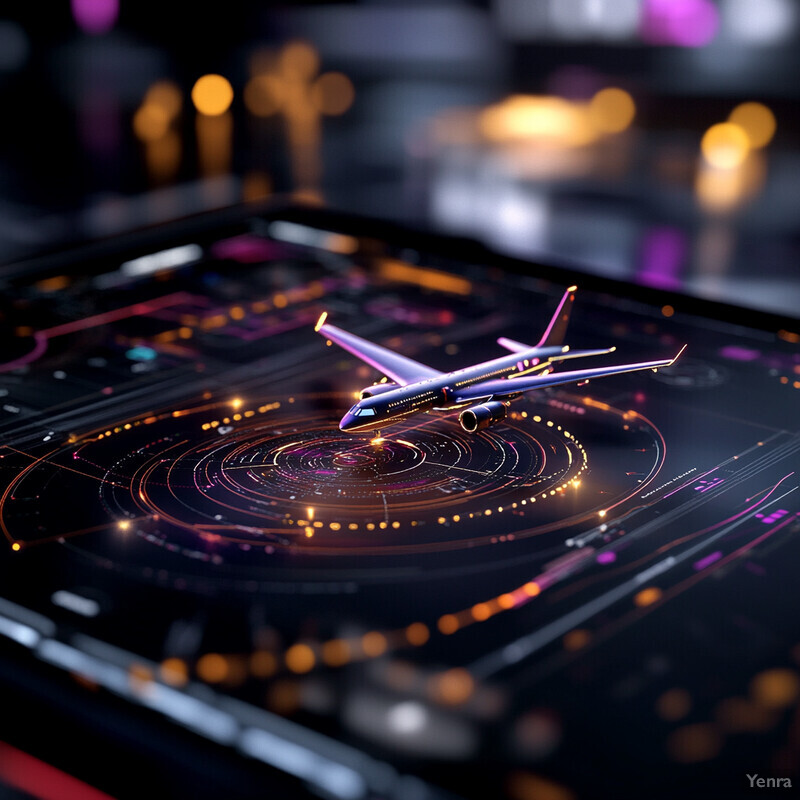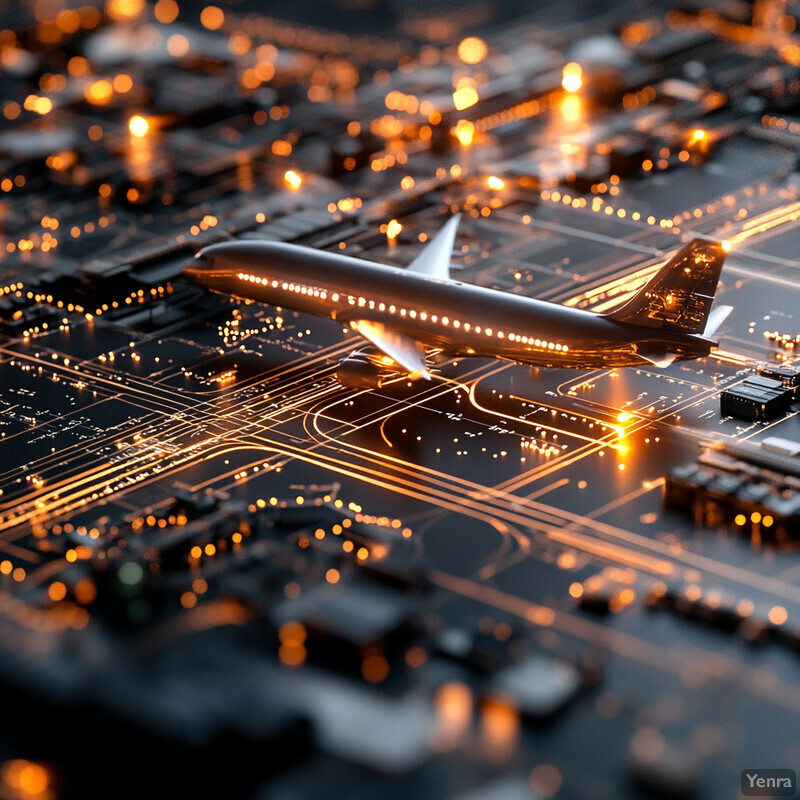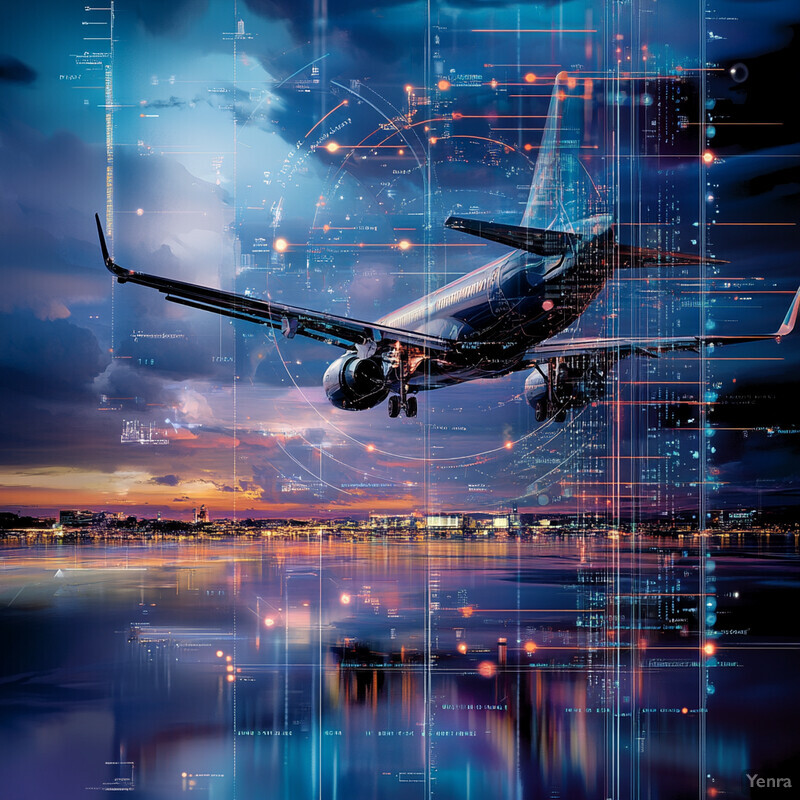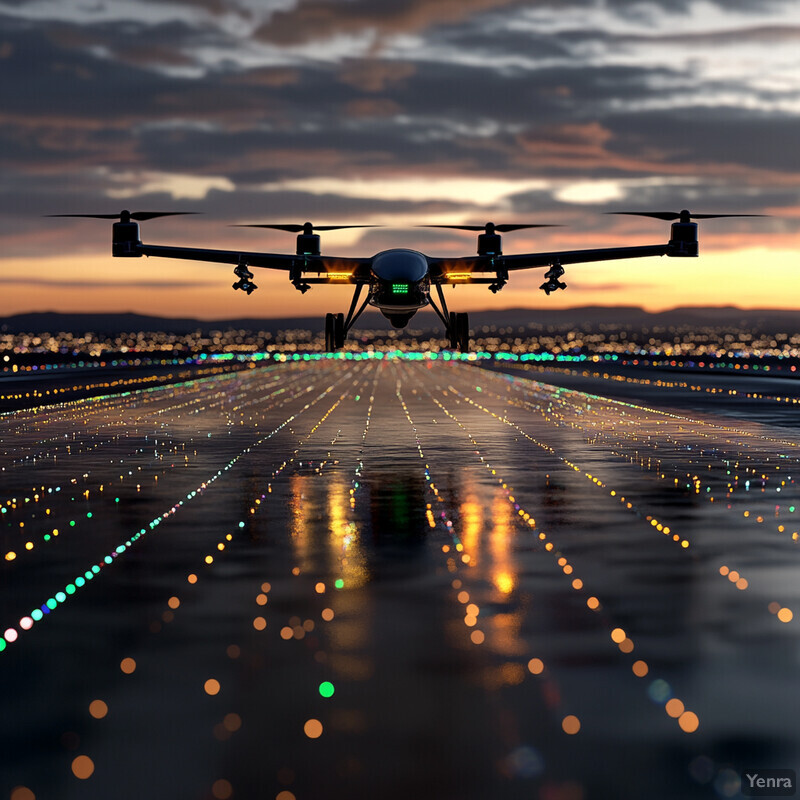1. Predictive Traffic Flow Management
AI enhances traffic flow forecasting by analyzing large-scale flight data and identifying trends. Machine learning models use historical schedules, weather, and real-time data to predict future traffic demand across the airspace. These forecasts support proactive flow management decisions, such as reroutes or ground delays, to balance demand and capacity. By anticipating congested routes or airports, AI-driven traffic flow management helps avoid bottlenecks and optimize resource use. Improved prediction accuracy allows controllers and traffic managers to implement measures earlier, reducing delays and improving efficiency.

Recent deep learning models have demonstrated significant gains in traffic flow prediction accuracy. For example, Huang, Yang, and Yan (2025) developed a Dynamic Multi-Graph Convolutional Spatial-Temporal Network (DMCSTN) to forecast airport arrival flows. In simulations, their DMCSTN model achieved a 12.6% reduction in mean absolute error (MAE) and a 3.6% improvement in root mean squared error (RMSE) for one-hour-ahead predictions compared to baseline methods. Such improvements in forecasting help ensure controllers have a clearer picture of evolving traffic, allowing more informed flow management.
2. Dynamic Airspace Configuration
AI enables flexible, on-demand airspace designs that adapt to traffic levels and controller workload. Machine learning and optimization algorithms can propose sector boundaries or control zones that change dynamically. This allows airspace sectors to expand, contract, or split based on real-time demand, balancing controller workload and minimizing unnecessary restrictions. Adaptive sectorization driven by AI can unlock underutilized capacity during off-peak times and provide additional capacity during peaks. By automating the reconfiguration process, AI supports more efficient use of airspace and can reduce delays through shorter routes and improved traffic distribution.

A recent SESAR project is exploring exactly this concept. The 2024 SMARTS project uses machine learning and optimization to redesign airspace sectors dynamically. According to SESAR, this AI-driven sectorization aims to “reduce passenger delays, unlock shorter routes, [and] lower emissions” while easing controllers’ workload by automating dynamic airspace changes. The expectation is that AI-suggested sector boundaries will improve traffic throughput and efficiency under varying traffic scenarios.
3. Automated Conflict Detection and Resolution
AI assists in spotting and resolving flight conflicts (potential loss of separation) faster than humans alone. Machine learning models can continuously monitor live trajectories and alert controllers to conflicts earlier. In some research, AI also suggests optimal conflict-avoidance maneuvers (speed, heading, or altitude changes) that minimize disruption. These decision-support tools reduce controller workload by automating routine conflict checks. By predicting conflicts before they materialize, AI supports safer, smoother operations with fewer manual interventions.

In simulation studies, AI-based conflict resolution has shown strong performance. Sui et al. (2023) trained a deep reinforcement learning (DRL) “Tactical Conflict Solver” to issue conflict-resolution advisories. On 1,000 test conflict scenarios, the trained agent successfully resolved 87.1% of conflicts. Even when traffic density was increased by 40%, the resolution rate only dropped slightly to 81.2%. These results suggest that AI can reliably automate many conflict detection and resolution tasks, helping to maintain safety as traffic grows.
4. Optimized Arrival and Departure Sequencing
AI and optimization algorithms improve runway throughput by reordering arriving and departing flights more efficiently than first-come-first-served. Advanced sequencing tools (e.g. enhanced AMAN/DMAN systems) can minimize total delays by considering aircraft characteristics, wake turbulence categories, and time windows. AI-driven sequencing can adapt in real time to disruptions, such as delays or weather, re-optimizing the sequence to maintain smooth flow. Better sequencing reduces holding times and taxi delays, improving punctuality and fuel efficiency.

Ma, Delahaye, and Liang (2024) formulated a mixed-integer optimization for multi-runway sequencing that simultaneously schedules landings, takeoffs, and crossing times. In computational experiments, their approach achieved “significantly fewer flight delays” compared to a simple first-come-first-served heuristic. This indicates that optimized sequencing (using AI-enabled solvers) can markedly reduce delays. Their study explicitly showed that incorporating runway assignments and separation rules into an AI/optimization model delivers better performance in minimizing total delay across flights.
5. Surface Movement Optimization
AI streamlines ground operations by optimizing taxi routes, pushback sequencing, and ramp management. Machine learning and multi-agent planners can coordinate aircraft, vehicles, and gates to reduce taxi times, prevent ground conflicts, and lower engine-on time. AI-based guidance considers the dynamic surface conditions (e.g. runway configurations, ground traffic) to route each aircraft efficiently. This improves on traditional A-SMGCS automation by proactively planning movements, leading to less congestion on taxiways and shorter taxi-out/in times.

A 2023 SESAR exploratory study of autonomous taxi planning found that an AI-driven multi-agent system significantly cut taxi times. Von der Burg and Sharpanskykh (2023) simulated fully-automated ground operations at Amsterdam Schiphol using advanced multi-agent motion planning. They reported that this AI-based system achieved 15% lower taxi times for both arriving and departing flights compared to the historical baseline. Such reductions mean less fuel burn and quicker gate turnaround, demonstrating the benefits of AI in surface movement optimization.
6. Enhanced Weather Forecast Integration
AI improves the use of weather data by generating high-resolution, localized forecasts (e.g. wind shear, turbulence, convective activity) tailored for ATC. Machine learning models can fuse sensor data (radar, lidar, satellite) to predict hazardous weather near airports or en route. Integrating these AI forecasts into ATC systems allows controllers to proactively manage flights around adverse weather. This leads to safer operations and reduced weather-induced delays, since controllers can re-route or hold flights earlier based on more accurate, timely weather information.

As one example, Khattak et al. (2023) applied ML to Doppler LIDAR data at Hong Kong International Airport to forecast intense low-level wind shear, a major runway hazard. Using a Bayesian-optimized XGBoost model, they achieved an R² of 0.859 in predicting future wind shear intensity. This high accuracy suggests AI forecasts can reliably identify upcoming hazardous wind conditions. Controllers armed with such predictions could adjust flight paths or schedules to avoid dangerous encounters.
7. Trajectory-Based Operations (TBO) Support
AI enhances Trajectory-Based Operations by improving 4D trajectory planning and prediction. Machine learning models refine flight trajectory predictions by learning from past flights, aircraft performance, and environmental data. Controllers and traffic managers can then use these AI-generated “four-dimensional” trajectories (3D space + time) to optimize routes and clearances. AI-driven TBO support allows more precise metering of arrivals/departures and better integration of airborne and ground planning. Overall, AI makes TBO more adaptive and accurate, improving on-time performance and efficiency.

NASA and FAA research have focused on integrating AI into TBO concepts. For instance, Coupe et al. (2023) describe NASA’s conversion of legacy surface scheduling into a machine-learned decision support service. They note that TBO concepts for arrival, departure, and surface (as in the Integrated Arrival-Departure-Surface system) have been under development to improve traffic flow. While these efforts are ongoing, the deployment of ML-based modules (e.g. trajectory predictors) is intended to scale TBO capabilities across the NAS, enabling smarter flow management.
8. Controller Decision Support Tools
AI augments controllers with decision aids for planning and tactical tasks. Tools might include conflict resolution advisors, speed/capability suggestion engines, or strategic planning assistants. By analyzing traffic and flight intent data, AI can propose options (e.g. reroutes, speed changes) that minimize delays or fuel burn. These AI-driven tools aim to reduce controller workload by offering solutions or alerts, rather than replacing the controller. They support faster, more consistent decision-making, especially in high-traffic or complex situations.

Operational projects are already exploring AI in support tools. For example, Eurocontrol and industry have developed AI-powered assistants (e.g. projects named LORD and Charlie) to provide real-time conflict-resolution advisories and optimization hints. A 2024 report noted that these AI/ML tools are designed to “provide conflict resolution support for controllers, reducing cognitive load” and enabling controllers to manage more traffic. Early feedback suggests controllers benefit from having AI-suggested options that they can accept or modify.
9. Speech Recognition and Natural Language Processing
AI voice-recognition and NLP tools transcribe and interpret controller-pilot communications or internal meetings. Automatic speech recognition (ASR) can create real-time text logs of voice exchanges, making them searchable and analyzable. NLP can then extract key information (e.g. flight numbers, clearances, issues) and populate digital records. These capabilities reduce manual transcription tasks and enable downstream automation (like automated data entry into ATC systems). Over time, controllers could receive AI summaries or alerts based on spoken communications, improving situational awareness.

In a 2023 NASA study, engineers fine-tuned a cloud-based ASR model on ~20 hours of FAA traffic flow management teleconference audio. After training, the system achieved an average word error rate of 6.81%, demonstrating effective recognition of technical aviation terminology. The resulting transcripts (made accessible and searchable by default) can feed NLP systems for tasks like flight information extraction or intent classification. This illustrates that domain-specific ASR can reliably process ATC-related speech, paving the way for AI to automate routine voice-data tasks.
10. Noise and Emission Reduction
AI optimizes flight profiles and routes to minimize fuel burn and noise, contributing to greener ATC operations. Machine learning can learn fuel-efficient vertical profiles (e.g. continuous climbs and descents) and quieter approach/departure paths. It also enables dynamic rerouting around congested airspace to avoid holding patterns that increase emissions. Airports use AI to simulate noise impacts and adjust flight schedules for noise abatement. Overall, AI-driven planning helps reduce carbon emissions and community noise exposure by fine-tuning aircraft trajectories.

Research projects explicitly include emission goals. The SESAR 2024 SMARTS sectorization study cited above aims not only to reduce delays but also to “lower emissions” via smarter airspace design. In another example (FAA data on optimized descents), smooth continuous profiles at major airports have saved on the order of millions of gallons of fuel and tens of millions of pounds of CO₂ per year (FAA data). Although those figures pre-date 2023, they illustrate the potential: implementing AI-optimized descent and climb procedures can achieve comparable environmental benefits on a daily basis.
11. Unmanned Aerial Vehicles (UAV) Integration
AI aids the safe integration of drones by enabling UAS Traffic Management (UTM) systems that deconflict UAVs from manned flights. Machine learning algorithms can autonomously re-plan drone trajectories in real time to avoid both known and unexpected traffic. AI also helps manage “U-space” services (e.g. dynamic geo-fencing, cluster routing) by rapidly processing shared airspace status and providing constraints to UAV operators. The result is a collaborative ecosystem where AI ensures drones meet safety constraints without overloading traditional ATC.

The FAA describes UTM as “a cooperative ecosystem” managed by automated systems rather than voice control. This means that as UTM services mature, AI-driven data exchanges (via APIs) will dynamically allocate airspace and handle reroutes for drones. For example, in recent UTM trials, automated deconfliction algorithms have been shown to effectively maintain separation between unmanned and manned aircraft (FAA commentary, 2023). However, comprehensive performance figures in mixed UAS/manned traffic are still under evaluation.
12. Automation of Routine Tasks
AI automates repetitive administrative tasks in ATC, freeing controllers for higher-level work. Examples include automatic flight plan processing, transcript generation, and logbook updates. For instance, voice transcripts from radio communications or meetings can be auto-parsed to extract key details. AI chatbots or virtual assistants might handle standard queries or clearance filings. By handling clerical chores, AI reduces controller workload and potential errors from manual entry.

In the NASA study above, the baseline ASR system not only achieved low error rates but also “provides a digital version of each planning webinar, making it accessible and text-searchable”. This means controllers and planners no longer have to manually transcribe or listen to recorded meetings – the AI does it. Such automation of transcription is one example of routine work (record-keeping and data extraction) being handed to AI, significantly reducing manual effort.
13. Air Traffic Flow Management Collaboration
AI platforms facilitate real-time collaboration between airlines, airports, and flow managers. By sharing AI-analyzed data (like demand forecasts or weather impact), stakeholders can collectively adjust schedules. AI-enabled systems merge surveillance and flight plan data (e.g. space-based ADS-B) across regions, providing a common operational picture. This allows coordinated rerouting or slot reallocation to prevent cross-boundary congestion. In essence, AI strengthens the flow management network by automating data exchange and joint decision-making.

In 2025, Aireon and Thales announced a collaboration integrating space-based ADS-B data (AireonFLOW) with Thales’ TopSky Flow Manager. They claim this combined system will provide “unmatched accuracy in demand forecasting and flight trajectory prediction,” enabling smarter regulation of flows and resolving congestion across flight information regions. This example shows how shared AI-driven data platforms can improve predictability and coordinated flow decisions across a wide area.